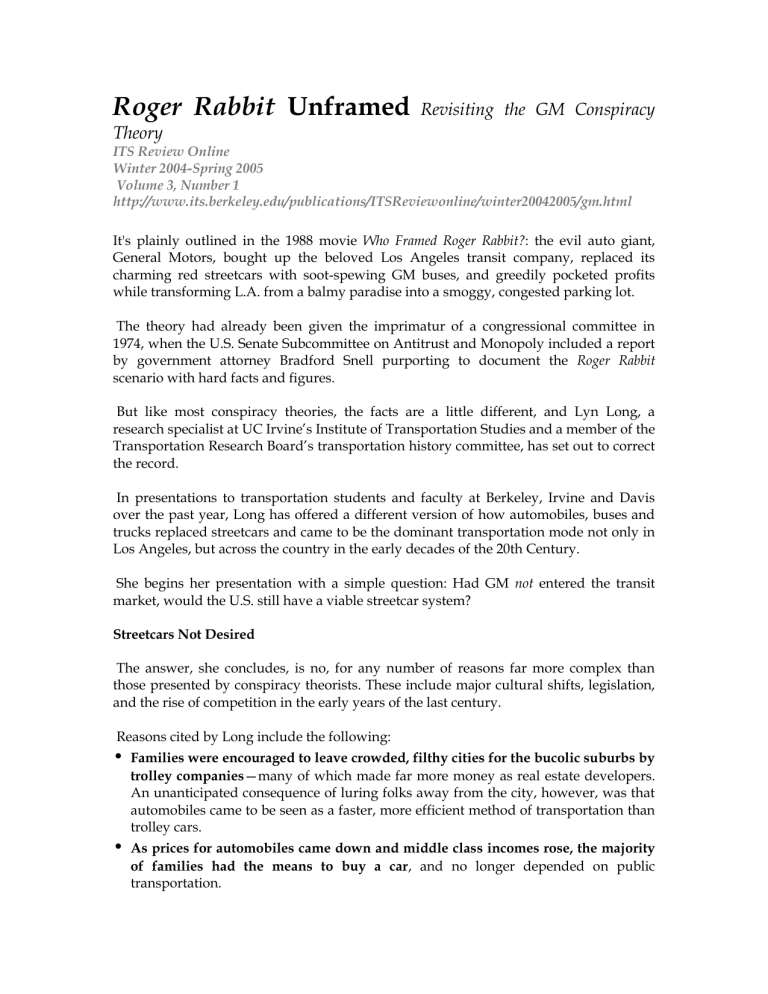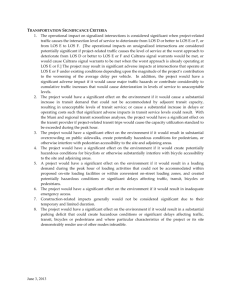rrunframed

Roger Rabbit Unframed
Revisiting the GM Conspiracy
Theory
ITS Review Online
Winter 2004-Spring 2005
Volume 3, Number 1 http://www.its.berkeley.edu/publications/ITSReviewonline/winter20042005/gm.html
It's plainly outlined in the 1988 movie Who Framed Roger Rabbit?: the evil auto giant,
General Motors, bought up the beloved Los Angeles transit company, replaced its charming red streetcars with soot-spewing GM buses, and greedily pocketed profits while transforming L.A. from a balmy paradise into a smoggy, congested parking lot.
The theory had already been given the imprimatur of a congressional committee in
1974, when the U.S. Senate Subcommittee on Antitrust and Monopoly included a report by government attorney Bradford Snell purporting to document the Roger Rabbit scenario with hard facts and figures.
But like most conspiracy theories, the facts are a little different, and Lyn Long, a research specialist at UC Irvine’s Institute of Transportation Studies and a member of the
Transportation Research Board’s transportation history committee, has set out to correct the record.
In presentations to transportation students and faculty at Berkeley, Irvine and Davis over the past year, Long has offered a different version of how automobiles, buses and trucks replaced streetcars and came to be the dominant transportation mode not only in
Los Angeles, but across the country in the early decades of the 20th Century.
She begins her presentation with a simple question: Had GM not entered the transit market, would the U.S. still have a viable streetcar system?
Streetcars Not Desired
The answer, she concludes, is no, for any number of reasons far more complex than those presented by conspiracy theorists. These include major cultural shifts, legislation, and the rise of competition in the early years of the last century.
Reasons cited by Long include the following:
• Families were encouraged to leave crowded, filthy cities for the bucolic suburbs by
trolley companies—many of which made far more money as real estate developers.
An unanticipated consequence of luring folks away from the city, however, was that automobiles came to be seen as a faster, more efficient method of transportation than trolley cars.
•
As prices for automobiles came down and middle class incomes rose, the majority
of families had the means to buy a car, and no longer depended on public transportation.
• Married women began moving into the work force in about 1920 and have been steadily doing so ever since. Then as now, mothers can juggle work, household duties, and caring for children more easily when they can drive.
• Transit companies were never viewed by the public as offering a public service; they were reviled as monopolistic and greedy operators whose trolleys were filthy and so slow that sometimes it was faster to walk.
• When companies looked for government subsidies to bail them out, they found no
support from the public, which had already begun to embrace the automobile.
•
Unable to acquire public subsidies, and with no capital to replace aging cars, many
streetcar companies merged with larger electric utility companies. In 1935, however, the federal government passed legislation that enabled utility companies to jettison their unprofitable streetcar subsidiaries, which they promptly did, and the subsidiaries failed.
• Even before the automobile became ubiquitous, competition arose from other
modes of transportation like the jitney, an automobile that carried passengers for a nickel along routes that ran parallel to the trolley line. A few years later, the independent motor bus made its debut, providing far greater flexibility for transportation in rapidly developing suburbs as well as congested inner cities where they were simply more maneuverable.
•
Finally, Long disputes Snell’s theory by pointing to other countries. Trolley car companies were failing before GM entered the market—not only in American cities but in Britain where GM had no influence.
So, if changing culture, legislation and competition pulled the plug on the nation’s electric cars, how did GM come to be blamed?
Or, as one critic opined, “How the hell could GM destroy an entire industry when they make such crappy cars?”
A Perfect Theory
Bradford Snell claimed to have the answer. With a grant from the Stern Fund, which was administered by New York University’s School of Business, he wrote “American
Ground Transport” in 1973. The following year, it was printed as an appendix to the
U.S. Senate’s Subcommittee on Antitrust and Monopoly’s hearings on the Industrial
Reorganization Act.
Snell argued that General Motors was like a "sovereign economic state, whose common control of auto, truck, bus and locomotive production was a major factor in the displacement of rail and bus transportation by cars and trucks….This study strongly suggests that a monopoly in ground vehicle production has led inexorably to a breakdown in this Nation’s ground transportation…” Los Angeles, in particular, was ruined by GM, he claimed, “turning earlier patrons of the high-speed rail system from public transit…”and transforming the city into an “ecological wasteland.”
Long believes Snell’s theory attracted adherents because it coincided with the Arab oil embargo of 1973. The resulting long lines at gas stations prompted Americans to think nostalgically about mass transit, and it was easier to be positive about the possibilities of future transit if past failures could be blamed on an evil corporation rather than a complex set of events.
"A similar thing happened in the Sixties when cities were declining and unemployment was high,” explained Long. “People thought that if only there were more transit it would help revitalize the cities. And inevitably, the more transit becomes a panacea for something, the conspiracy theory pops up. When detractors say transit won’t fix the problem, the conspiracy is brought up as the reason it didn’t work in the past. That way, it’s not transit’s fault.“
Snell’s arguments may have also captured the public interest because they contained a small nugget of truth. In 1944, National City Lines (NCL), a subsidiary of General
Motors, did buy the Los Angeles Railway and replaced some streetcar lines with buses.
However, the previous owner, Los Angeles Railway, had already introduced buses 15 years earlier. In 1947, General Motors and NCL were charged, along with seven other corporations, with conspiring to acquire control of a number of transit companies, as well as conspiring to monopolize sales of buses and supplies to companies owned by
NCL.
All were acquitted on the first count, but GM was convicted on the second—conspiring to have GM-owned transit companies buy only GM buses. As for L.A.’s famous Pacific
Electric line with its red cars—it was never owned by the GM-National City Lines combine. Southern Pacific Railroad owned the company until 1953 when it was sold to
Metropolitan Coach Lines. A few years later it was sold again to the Los Angeles
Metropolitan Transit Authority, which dismantled the line in 1961.
Snell’s conspiracy theory was dredged up again in 1996 when an independent film titled Taken for a Ride was broadcast on the PBS series Point of View. The film reiterated much of the information Snell had presented 20 years earlier.
When delivering her presentation, Long found that Davis and Berkeley students, many of whom bike or use public transit to get around, express a "nagging nostalgia” for transit. “They think transit should work, and it’s so much better for the environment. Of course it’s different when you’re 20 and can bike or walk to transit,” said Long.
In the end, Long believes the car is here to stay, and warns that few proposed rail projects in California are likely to succeed. “We’re fighting a mode that has beat out all other technologies. We’ll never be a transit-dependent society.”
—Christine Cosgrove








